Worksheet Solutions: Data Handling | Mathematics for Class 5 PDF Download

Q1: Aryan is a healthy boy. He is keeping check of his height every year. Look at the bar graph and answer the following questions: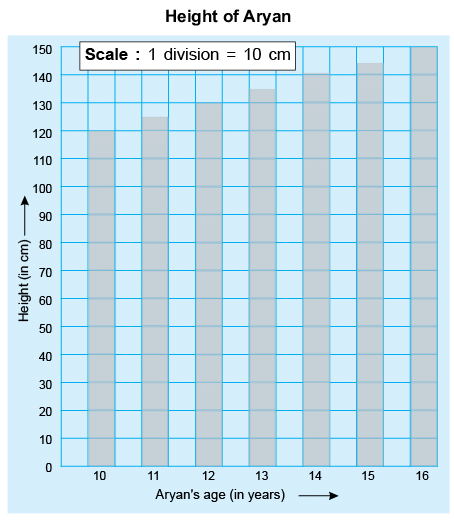 1. What was his height at the age of 15?
1. What was his height at the age of 15?
2. What is the scale used?
3. What information is depicted by the vertical axis?
Ans: 1. Looking at the bar graph, the height of Aryan at the age of 15 appears to be around 140 cm.
2. The scale mentioned in the graph is: 1 division = 10 cm.
3. The vertical axis depicts height in centimeters (cm).
Q2: The following table shows the number of students who secured more than 90 marks in Mathematics in each class.
Draw a bar graph to represent the above data. Also, answer the following questions:
1. In which two classes, equal number of students secured more than 90 marks?
2. In which class, maximum number of students secured more than 90 marks?
Ans: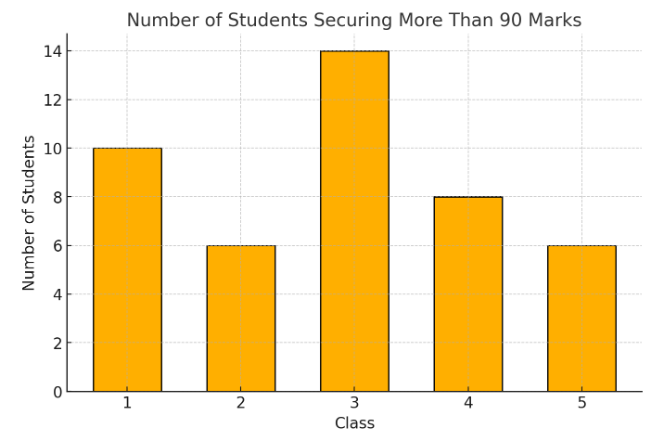 1. Classes 2 and 5 have an equal number of students, which is 6.
1. Classes 2 and 5 have an equal number of students, which is 6.
2. The maximum number of students secured more than 90 marks in Class 3, with 14 students.
Q3: The following table shows the number of comics read by students during the summer vacations.
Draw a bar graph to represent the above table.
1. How many students read more than 5 comics?
2. How many more comics did Aman read than Sanjeev?
Ans: 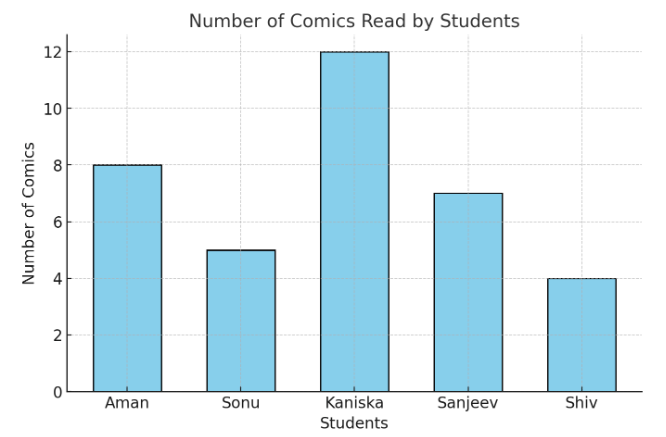
1. Students who read more than 5 comics: Aman (8), Kaniska (12), and Sanjeev (7).
3 students read more than 5 comics.
2. Number of comics Aman read = 8
Number of comics Sanjeev read = 7
Difference = 8 − 7 = 1
Aman read 1 more comic than Sanjeev.
Q4: Look at the bar graph and answer the following questions: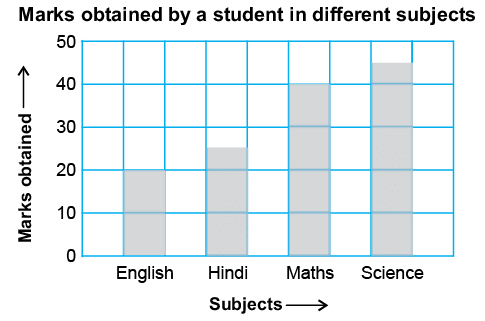 1. In which subject, did the student score maximum marks?
1. In which subject, did the student score maximum marks?
2. Write the total number of marks obtained by the student.
Ans: 1. From the graph, the student scored the highest marks in Science, which is 50 marks.
2. Marks scored in each subject:
English: 20 marks
Hindi: 25 marks
Maths: 40 marks
Science: 45 marks
Total marks = 20 + 25 + 40= 130.
Q5: Draw a bar graph to represent the following table:
Answer the following questions:
1. Which vehicle is minimum in number?
2. How many cycles are more than the scooters?
Ans: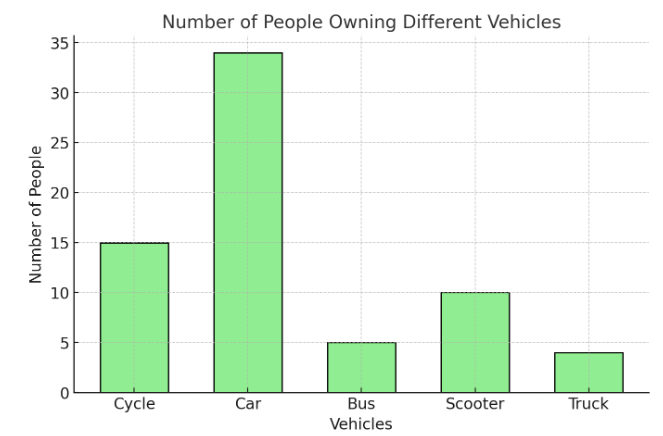
1. From the data, Truck is minimum in number with 4 people owning it.
2. Number of cycles = 15
Number of scooters = 10
Difference = 15 − 10 = 5
5 more cycles than scooters.
Q6: Following Pie chart depicts the mode of transport used by children to come to the school. Look at the Pie chart and answer the following questions: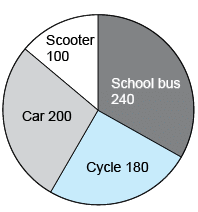 1. What fraction of the children uses car as their mode of transport?
1. What fraction of the children uses car as their mode of transport?
2. How many children are there in the school?
3. What fraction of the children uses scooter as their mode of transport?
Ans: 1. Number of children using a car = 200
Total number of children = 240 + 180 + 200 + 100 = 720
Fraction = 200/720 = 5/18
2. Total number of children = 240 + 180 + 200 + 100 = 720.
3. Number of children using a scooter = 100
Total number of children = 720
Fraction = 100/720 = 5/36
Q7: The given Pie chart shows the different pets kept by the people of a society. Look at the Pie chart and answer the following questions: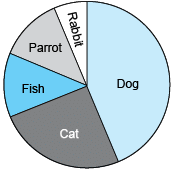
1. Which two pets are equally popular?
2. Which is the most popular pet?
Ans:
1. From the Pie chart, Parrot and Fish are equally popular as they occupy the same size of the segment.
2. From the Pie chart, Dog is the most popular pet as it has the largest segment.
Q8: The Pie chart for different fast foods liked by the students of a class is given below. Observe the graph and answer the following questions: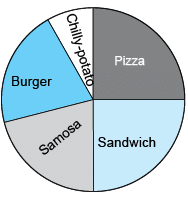 1. If 20 students like Sandwich, how many students are there in the class?
1. If 20 students like Sandwich, how many students are there in the class?
2. Which food is most popular?
3. Which foods are liked by equal number of students?
Ans: 1. The segment representing "Sandwich" corresponds to 1/4 of the total circle.
Let the total number of students in the class be x:
1/4 × x = 20
x = 20 × 4 = 80
There are 80 students in the class.
2. From the Pie chart, "Pizza" and "Sandwich" have the largest segments, indicating them as the most popular.
3. From the graph, "Burger" and "Samosa" have equal-sized segments, meaning they are liked by an equal number of students. Similarly, Pizza and Sandwich have equal-sized segments as well.
Q9: The given Pie Chart shows how Shikha spends her time at school in different activities. Study the Pie Chart and answer the following questions: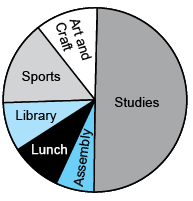 1. If Shikha spends 6 hours in school, how many hours does she study there?
1. If Shikha spends 6 hours in school, how many hours does she study there?
2. On which activity, does she spend half of her time?
Ans: 1. From the Pie chart, the "Studies" segment takes up 50% of the total time.
Time spent studying = 50 % × 6 hours = 3 hours.
Shikha studies for 3 hours.
2. From the graph, the "Studies" segment occupies half of the circle, indicating that she spends half her time studying.
Q10: The following line-graph shows the number of students ages between 9 years to 15 years in a school.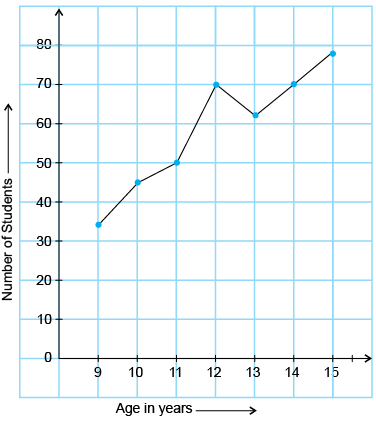 Observe the line graph and answer the following questions.
Observe the line graph and answer the following questions.
1. What was the greatest number of students at an age?
2. What is the range of value on the horizontal axis?
Ans: 1. From the line graph, the greatest number of students is around 80, which occurs at the age of 15 years.
2. The horizontal axis represents the age of students, ranging from 9 years to 15 years.
The range is 15 − 9 = 6 years.
Q11: The following line-graph shows the performance of a student during a year in class V.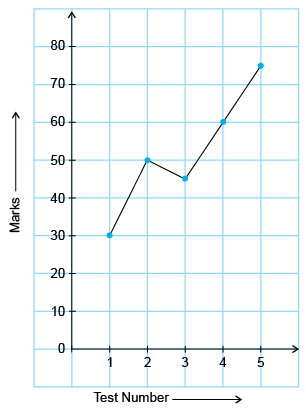 Study the line-graph and answer the following questions:
Study the line-graph and answer the following questions:
1. What is the range of value on the vertical scale?
2. In which test did he show his best perfomance?
3. In which test the student secured least marks?
Ans: 1. The vertical scale represents the marks obtained by the student, ranging from 0 to 80.
Range = 80 − 0 = 80.
2. From the graph, the student scored the highest marks (75 marks) in Test 5.
3. From the graph, the student scored the lowest marks (30 marks) in Test 1.
Q12: The following line graph shows the temperature of different days in New Delhi. Read the above line graph and answer the following questions:
Read the above line graph and answer the following questions:
1. How many points are in the graph?
2. What is the highest temperature recorded?
3. What is the range of values on the horizontal scale?
Ans: 1. The graph shows the temperature for 6 days: Monday, Tuesday, Wednesday, Thursday, Friday, and Saturday.
2. From the graph, the highest temperature recorded is 65°F, on Saturday.
3. The horizontal scale represents the days, ranging from Monday to Saturday.
Q13: The pie chart shows the different games played by the students of a class. Which two games are played by half of the students?
Ans: From the pie chart, Chess and Hockey together account for half of the circle, meaning they are played by half of the students.
Q14: The following bar graph shows the rainfall (in cm) at a place during 6 months of a year:
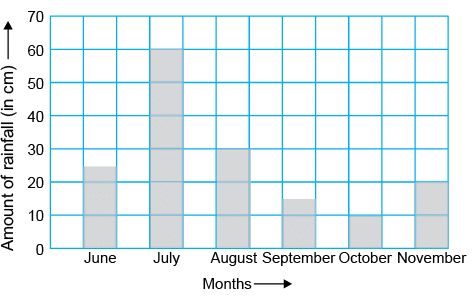
Ans: From the bar graph, the maximum rainfall (60 cm) occurred in July.
From the bar graph, the minimum rainfall (10 cm) occurred in October.
Q15: The following bar graphs show the age, height and weight of four girls. Observe these bar graphs and answer the questions that follow:
 1. Is the tallest girl the heaviest also?
1. Is the tallest girl the heaviest also?
2. Is it possible for an 8 year old girl to be taller than a 12 year old girl?
3. Is the youngest girl the lightest also?
Ans: 1. From the graphs:
- The tallest girl is Neetu (height: 120 cm).
- The heaviest girl is Shakshi (weight: 50 kg).
No, the tallest girl is not the heaviest.
2. From the graphs: Neetu is 12 years old and taller (120 cm) than Shakshi, who is 8 years old (110 cm).
Yes, it is possible.
3. From the graphs:
- The youngest girls are Urmila and Rashmi (6 years old).
- The lightest girl is also Rashmi (weight: 20 kg).
Yes, the youngest girl is the lightest.
|
56 videos|223 docs|40 tests
|
FAQs on Worksheet Solutions: Data Handling - Mathematics for Class 5
| 1. What is data handling in Class 5? |  |
| 2. Why is it important for Class 5 students to learn data handling? |  |
| 3. What types of data representation methods are taught in Class 5? |  |
| 4. How can students practice data handling at home? |  |
| 5. What role does technology play in data handling for Class 5 students? |  |
















